36105
•
7-minute read


Negative SEO is a controversial topic in the SEO space. You hear about it a lot, but does it happen quite so often? How easy is it to ruin a competitor's rankings? Could it be the reason your rankings suddenly dropped? Should you be worried? How do you know if someone is trying to knock you out of SERPs with negative SEO? Is there anything you can do to stay safe? Let's take these questions one by one.
Negative SEO is a set of activities aimed at decreasing a competitor's site rankings in search engines' results. These activities may include knowingly building spammy, unnatural links to the site, content scraping, and even hacking the site.
From day one, Google did its best to identify unnatural links when evaluating web page authority. Originally, spammy links were simply ignored — they did not pass any link juice and that was it. And SEOs took advantage of the system by building and buying thousands (sometimes millions) of backlinks. Those that passed the test were helping rank the site, and those that didn't… simply didn't, without harming the site.
In April 2012, Google launched the Penguin update, and, for the first time, they would be taking strong punitive action against sites with manipulative links. It meant you could no longer use low-quality links to rank your website. At the same time, it meant you could buy low-quality links for your competitor's website and have it penalized by Google. That's when negative SEO took off:
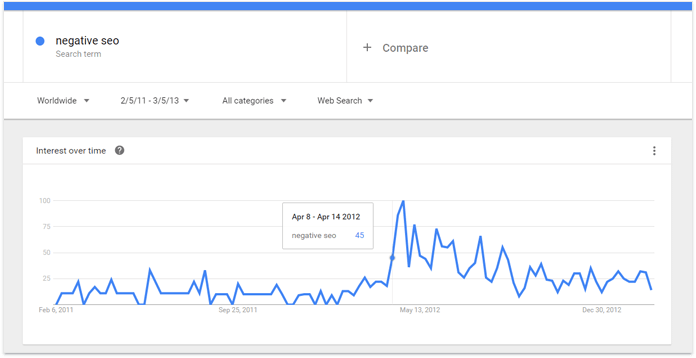
Does Google have anything to say on the matter? They do acknowledge that negative SEO attacks happen, although not too often.
We work really hard to prevent these things from causing any problems. We work hard on our algorithms to try to recognize this kind of problems and catch them ahead of time. In practice, I rarely see any issues around that and when I do see an issue where I think that maybe this is created by a competitor then usually the team is willing to look into the details and see what happened there and make sure that this isn't an issue that is artificially causing problems for a website.
Great response! I would prefer the more straightforward: "No, negative SEO does not work" — but we'll have to make do with what we have. Remember that Google has claimed again and again that negative SEO is unlikely to work and is in fact extremely rare, and as their algorithms grow more and more sophisticated, you're safer and safer from such an occurrence. Unfortunately, it's not completely out of the question just yet.
Today, most websites are completely safe from negative SEO attacks. Google has gotten pretty good at catching spammy backlink blasts, so these types of attacks are unlikely to influence your rankings even if they happen. So, if you see your rankings suddenly drop, then make sure to go through a checklist of common reasons before you blame a negative SEO attack.
There are, of course, more sophisticated types of negative SEO, building "legitimate" low-quality backlinks over long periods of time. But these campaigns are quite expensive to organize and they are hardly ever worth it. Unless you are an online casino or a predatory loan company — these are about the only niches where old school negative SEO still happens.
In fact, you are more likely to fall victim to a negative SEO attack mounted from within your own company. For example, you might make the mistake of hiring an inexperienced SEO specialist, who will build a ton of low-quality backlinks to your website, or spam your comment section, or pay for fake reviews. Or you might hire a dishonest writer who will plagiarize most of their copy from other websites. Realistically, these types of negative SEO "attacks" pose a much higher risk than an actual attack from your competitor.
Of course, from a technical standpoint, it makes no difference whether an SEO attack comes from outside or from inside — it hurts your rankings in the exact same way. So, let's look at the different shapes negative SEO can take, and examine the ways to stay safe from each one.
Generally, a single spammy link (even if it's sitewide) wouldn't be able to shatter a site's rankings, no matter how many quality links you held previously. That's why negative SEO typically involves links from a group of sites or link farms.
A link farm is a hub of interconnected websites. Starting out as somewhat of a Grey Hat technique, nowadays almost exclusively Black Hat, these sites used to link to each other to increase the link popularity of each site's pages. You could purchase links from these websites to increase your own site's PageRank. One example of a link farm is a PBN (private blog network) — sites created specifically for link building. Most PBNs are made up of expired domains, which means that the sites usually have accumulated some backlinks and authority by the time they become a part of a PBN.
In 2012, Google's Penguin algorithm made it significantly harder for link farms to be effective. If Google spots backlinks that come from a link farm, it may conclude that the linked-to site is involved in a link scheme, which will lead to a penalty. That's how link farming went from a black-hat to a negative SEO technique:

How to stay safe:
Preventing a negative SEO attack isn't something in your power. But, if you spot the attempt early enough, you can clean up your backlink profile before the damage is done. To manage that, you need to regularly monitor link profile growth. SEO SpyGlass, for example, provides a whole range of essential webmaster tools you can use to check negative SEO, including progress graphs for both the number of links in your profile and the number of referring domains.
An unusual spike in either of those graphs is reason enough to look into the links that your site suddenly acquired, giving you time to deal with potential spammers accordingly.
The typical graphs would look something like this:

On the other hand, if you see something like this when you haven't been actively building links, you may want to look into your backlink profile for links that resulted in the spike:
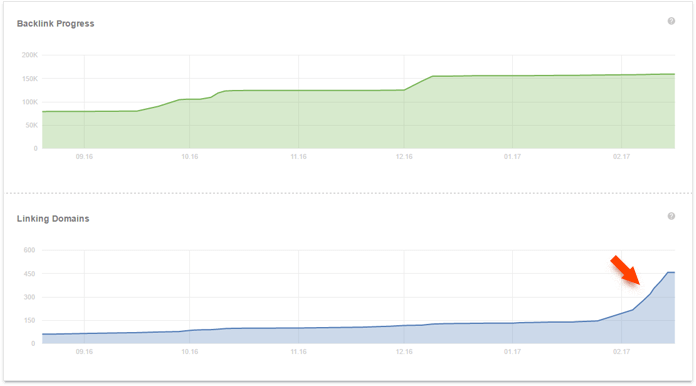
To see the actual sources of new links switch to either the Backlinks tab for exact URLs or the Linking Domains tab for the entire domains. Sort the list of backlinks by date and see if any of the new ones look suspicious.
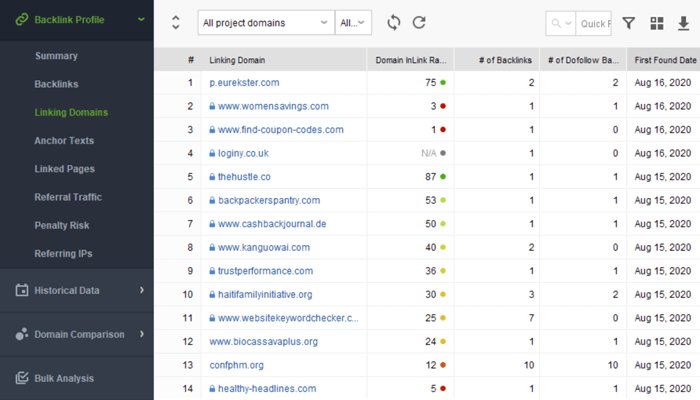
If you are not sure whether the new links are good or bad, you can switch to the Penalty Risk tab and see your entire backlink profile evaluated for the risk of being penalized by Google. Sort your list from highest to lowest risk and investigate everything with a high score:
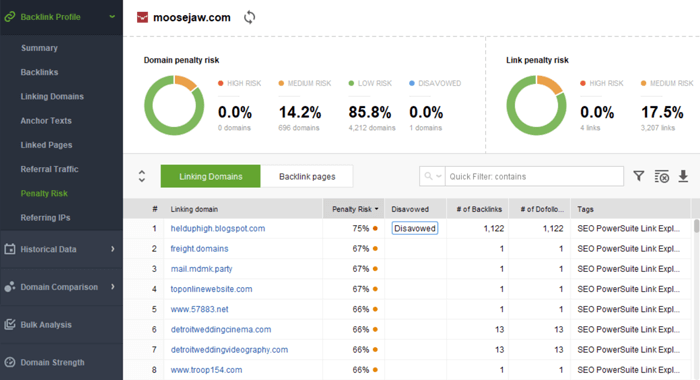
Finally, if you do find some of the links to be spammy, or you want to tidy up your backlink profile, you can add them to a disavow file, then download the file and submit it to Google's disavow tool. To do that, right-click the spammy backlink/linking domain and select Disavow (it typically makes more sense to disavow on the domain level, so make sure to select Entire domain under Disavow mode). Do the same for all unnatural links or domains you find:
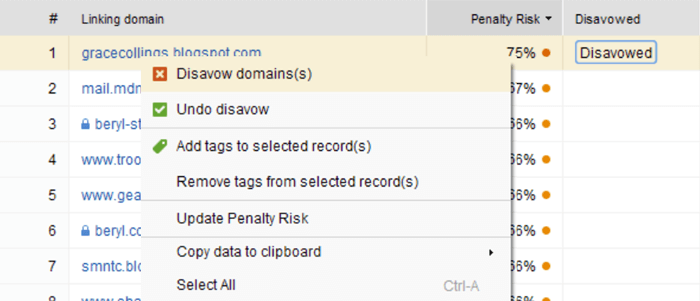
Then go to Preferences > Disavow/Blacklist backlinks, review your disavow file, and export it from the disavow tool once you're happy with it.
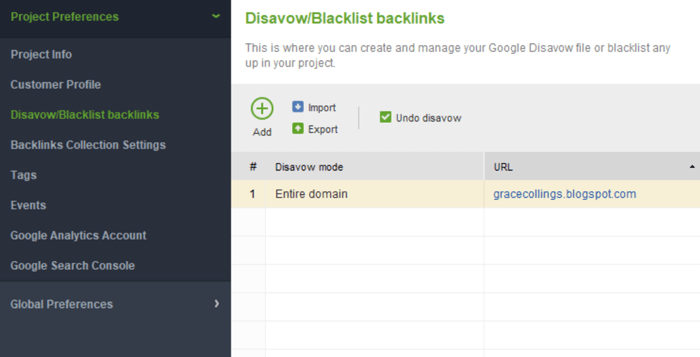
Another negative SEO technique is falsifying duplicate content. It involves scraping your site's content and copying it to other websites, often multiple times, sometimes even as part of the link farms discussed above.
You probably know that Google's Panda update was designed, in part, to detect and fight content duplication. So when Google finds content that is duplicated across multiple sites, they will usually pick only one version to rank. You'd hope that Google is clever enough to identify the original source of the content, and in most cases they are. Unless the scraped copy gets indexed before the original.
That's why scrapers often automatically copy new content and repost it right away. If Google finds the "stolen" version first, it may de-rank your site, and rank the scraper site instead.
How to stay safe: There are a few great tools designed to help you stay safe from scrapers. Copyscape is one of them. All you need to do is enter the URL of your content to find out if there are any duplicates of it online. If you do find scraped copies of your content, it's a good idea to first contact the webmaster asking them to remove the piece (although you might suspect they're not very likely to respond). If that's not effective, you may want to report the scraper using Google's copyright infringement report.
Like good quality links, good reviews mean a lot. An influx of negative ones isn't just bad for your local search engine rankings; it's bad for business. But reviews are relatively easy to manipulate, and they may be the first thing a jealous competitor will try to do.

How to stay safe: Obviously, you need to keep an eye on your Google My Business listing and look through new reviews your company gets. Fake reviews violate Google's policy, according to which, one should never "post reviews on behalf of others or misrepresent your identity or connection with the place you're reviewing".
When you're positive you've spotted a fake review, you can follow this guide on flagging inappropriate GMB reviews.
When they don't know better, a desperate competitor may try and crash your site altogether. This Black Hat SEO trick is achieved by forcefully crawling the site and thus causing heavy server loads. This may slow down the site or even crash it altogether. And if it happens a few times, you may lose some credibility with search engines.
How to stay safe: If you notice that your site is becoming slower, or, worse, crashes altogether, a wise thing to do is contact your hosting company or webmaster — they should be able to tell you where the additional load is from maintenance, organic traffic, or an attack on your website. They will also have a number of solutions like applying firewall rules or rerouting traffic through a DDoS protection service.
The aftermath of a hacking attack can wreak havoc on your website's ranking. Your website may be injected with low-quality or duplicate content, your links may be replaced, new links can be added, and your robots.txt file can be edited to mess with crawling. Among other things.
How to stay safe:
Regular site audits with a tool like WebSite Auditor is the best way to continuously check your site against such threats. To run an audit, simply launch WebSite Auditor and create a project for your site. To re-run it for an existing project, use the Rebuild Project button. As long as you do this regularly, you should be able to spot subtle changes that could otherwise go unnoticed.

Above, I've covered the most common negative SEO tactics and how you can protect yourself against them. But this list is not exhaustive: anything that can negatively affect your site's reputation has the potential to be used against you. If you have your own tips or additions to the list, please let me know in the comments below!